Abstract
To develop efficient utilization technologies for lignite, HyperCoal was prepared from the depolymerization of Shengli lignite by reacting it with NaOH and methanol. A series of HyperCoal extracts were obtained using different solvents and characterized using elemental analysis, Fourier-transform infrared spectroscopy, gel permeation chromatography, and synchronous fluorescence spectroscopy. The results indicate that solvent polarity is the primary factor influencing both the extraction yield and the structure of the extracts as polar solvents can disrupt or break hydrogen bonds within the extracts. The extraction yield increases with the polarity of the extraction solvent. HyperCoal is a complex mixture of aromatic derivatives containing alkyl substituents and oxygen-containing functional groups. The O/C ratio and molecular size of the extracts, the amount of oxygen-containing functional groups, the proportion of aromatic structures, and the size of aromatic nuclei in the extracts increase with increasing solvent polarity, while the H/C ratio and proportion of aliphatic structures decrease. These findings aid developing methods for producing high-value-added chemicals from HyperCoal through staged conversion.
1. Introduction
The minerals present in coal pose notable challenges for its utilization, prompting the development of various technologies to separate coal from its mineral content. One such technology is the HyperCoal (ashless coal) process, recognized as a clean coal technology [1,2,3]. HyperCoal is produced through the thermal extraction of coal using organic or industrial solvents—such as 1-methylnaphthalene and light cycle oil—at temperatures below 400 °C [4,5]. HyperCoal can also be produced through the coal depolymerization process, which is milder than traditional direct coal liquefaction (DCL) and referred to as HyperCoal from coal depolymerization (HPCD) [6]. HyperCoal comprises extractable organic components, is free of mineral matter, and exhibits high fluidity and calorific value. Compared with raw coal, HyperCoal offers several advantages. Hao et al. [7] and Zhao et al. [8] demonstrated that the addition of HyperCoal derived from low-rank coal enabled weakly caking coal to serve as a feedstock for coke production through adhesive and fusion mechanisms, thereby enhancing coke properties. Zou et al. [9] reported that HyperCoal achieved higher liquefaction conversion and oil yield than raw coal in hydro-liquefaction with a Ni–Mo–S/Al2O3 catalyst, which was recycled four times without no carbon deposition. Wang et al. [10] demonstrated that the catalytic gasification of HyperCoal showed a higher gasification rate than raw coals below 750 °C, with no catalyst deactivation. Zhao et al. [11] prepared activated carbons from HyperCoal by direct KOH activation, achieving a maximum BET surface area of 2440 m2 g−1, making it an excellent candidate for high-performance electrodes.
Lignite is a notable energy resource owing to its abundant reserves, but it is typically used as a low-grade fuel for electricity generation in many countries because of its high ash content, high moisture content, and relatively low net calorific value [6]. Producing HyperCoal from lignite is critical for advancing efficient lignite utilization technologies; however, the extraction yield of HyperCoal from lignite remains low due to the presence of hydrogen bonds among the functional groups in lignite [12,13,14]. Some studies have shown that lignite can achieve high extraction yields through reactions with alcohol and alkali [15], offering an effective approach for preparing HPCD from lignite. Our previous work demonstrated that lignite can be efficiently converted into HPCD with a yield exceeding 99%. HPCD may possess some potential applications, particularly via chemical conversions such as hydrogenation or oxidation for producing aromatics and their derivatives.
Understanding the structure of HPCD is a prerequisite for its utilization. For such complex mixtures, separation by solvent extraction prior to characterization and application is a commonly employed method. According to the principle of “like dissolves like”, components with similar physicochemical properties can be concentrated in specific solvent extracts, which reduces the complexity of the mixture and minimizes interference among components during analysis. Li et al. [16] employed solvents of varying polarities—petroleum ether, carbon disulfide, methanol, and acetone—to extract organic samples from soybean straw biochar and analyzed the extracts using Fourier-transform ion cyclotron resonance mass spectrometry. Each solvent was found to extract a high proportion of unique molecular formulas, a molecular diversity attributed to differences in solvent polarity and the ability of each solvent to disrupt different types of intermolecular bonds. Wang et al. [17] separated thermal extracts of Xianfeng lignite into subfractions by eluting a chromatographic column with mixed solvents of toluene and tetrahydrofuran (THF) in varying proportions. The structure of each subfraction was characterized to deduce the mechanisms underlying thermal extraction. Vargas et al. [18] divided asphaltene into p-nitrophenol-soluble and -insoluble fractions and investigated their structural differences at the nanometer scale using atomic force microscopy. They confirmed that, in all cases, aggregates of asphaltene molecules formed at very low concentrations with sizes predominantly between 2 and 10 nm. Chen et al. [19] prepared a series of soluble fractions through Soxhlet extraction with THF and pyridine as well as in situ thermal extraction using tetralin and 1-methylnaphthalene from lignite and sub-bituminous coal. The structural and property characteristics of these fractions were evaluated using multiple characterization techniques, providing critical insights into their transformation during the preheating stage of DCL and offering theoretical support for their efficient utilization.
In our preliminary study, HPCD was fractionated into hexane-soluble, hexane-insoluble/toluene-soluble, and toluene-insoluble/THF-soluble components using the classification method typically applied to DCL products, followed by the structural analysis and characterization of each fraction. The results show that HPCD is a complex mixture of aromatic derivatives containing oxygen-containing functional groups and alkyl substituents. The dominant reactions occurred during preparation of HPCD are the breakage of ether linkages of the lignite under the action of NaOH [20]. It was also found that HPCD readily converts into light products with low hydrogen consumption due to its lower molecular weight and reduced generation of free radicals during hydro-liquefaction [6]. However, due to differences in reaction mechanisms and conditions, HPCD substantially differs from coal liquefaction products. For instance, HPCD exhibits higher oxygen and hydrogen contents and a lower degree of aromatic ring condensation compared with coal liquefaction products. In addition, the proportion of toluene-insoluble/THF-soluble material exceeds 70%, indicating that this extraction-based classification method is relatively coarse. Therefore, more systematic approaches to HPCD fractionation and analysis are necessary for choosing more targeted conversion methods for each fraction. To explore appropriate methods to achieve the high-value-added and clean utilization of lignite, HPCD derived from Shengli (SL) lignite was separated into subfractions using a series of solvents with progressively varying polarities, and then the fractions were characterized using elemental analysis, Fourier-transform infrared (FTIR) spectroscopy, gel permeation chromatography (GPC), and synchronous fluorescence (SF) spectroscopy.
2. Materials and Methods
2.1. Materials
SL lignite (a Chinese lignite) was used in this study. Its ultimate and proximate analyses are presented in Table 1. The maceral content of SL lignite is shown in Table 2. The coal sample was ground to pass through a 200-mesh sieve and dried under vacuum at 110 °C for 24 h.

Table 1.
Ultimate and proximate analyses of SL lignite.

Table 2.
Maceral content of SL lignite.
n-Hexane, toluene, diethyl ether, ethyl acetate, and methanol were used to extract the HPCD. All solvents were commercially available pure chemical reagents (purity above 99.5%). The dipole moment (μ) is commonly used to characterize solvent polarity. Table 3 lists the dipole moments of the solvents, showing a gradual increase in polarity in the order of n-hexane, toluene, diethyl ether, ethyl acetate, and methanol.

Table 3.
Dipole moment of the solvents [21,22].
2.2. Preparation of HPCD
HPCD was prepared in a 30 mL stainless steel tubing reactor equipped for vertical agitation. One gram of dried coal and 1.0 g of NaOH were charged into the reactor along with 10 g of methanol. Prior to the reaction, the reactor was sealed and purged three times with nitrogen, then pressurized to an initial pressure of 0.1 MPa with nitrogen. The reactor was vertically agitated at 120 rpm and submerged in a 300 °C salt bath for 60 min. The pressure increased to about 10 MPa during the reaction. After the reaction, the reactor was quenched to ambient temperature in a water bath, and the internal pressure was slowly released. The reaction mixture was retrieved by washing with methanol. Methanol was removed via rotary evaporation to obtain solid products. These solids were acidified with hydrochloric acid, washed thoroughly with water, and filtered until the filtrate reached neutral pH (pH = 7). The filter residue—comprising HPCD, unreacted coal, and minerals—was dried under vacuum at 80 °C for 12 h. The preparation procedure of HPCD is shown in Figure 1.
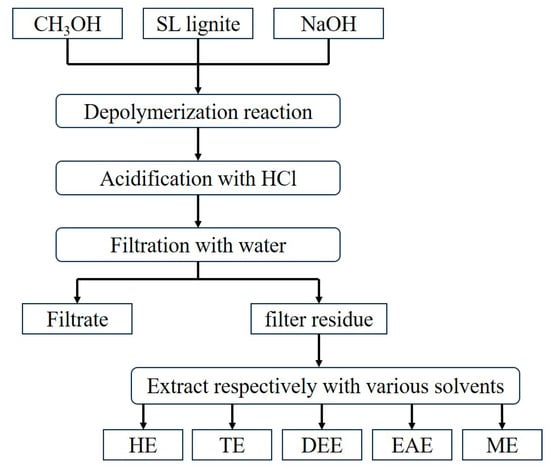
Figure 1.
Preparation and extraction procedure of HPCD.
2.3. Separation of HPCD via Solvent Extraction
Multiple batches of filter residues were prepared through parallel experiments and sequentially extracted using n-hexane, toluene, diethyl ether, ethyl acetate, and methanol. The extract solutions were subjected to vacuum evaporation to remove most of the solvent, followed by drying at 80 °C for 12 h to obtain the respective extracts. The n-hexane, toluene, diethyl ether, ethyl acetate, and methanol extracts were designated as HE, TE, DEE, EAE, and ME, respectively. The extraction procedure of HPCD is shown in Figure 1. The yields of HE (YHE), TE (YTE), DEE (YDEE), EAE (YEAE) and ME (YME) were calculated as the mass percentages of the respective extracts relative to the mass of dry-and-ash-free coal (mcoal, daf) as defined in Equations (1)–(5), where mHE, mTE, mDEE, mEAE, and mME are the masses of HE, TE, DEE, EAE, and ME, respectively.
YHE = mHE/mcoal,daf
YTE = mTE/mcoal,daf
YDEE = mDEE/mcoal,daf
YEAE = mEAE/mcoal,daf
YME = mME/mcoal,daf
Figure 2 shows the XRD pattern of the ash from SL lignite. The main components in coal ash are quartz, anhydrite, nepheline, gehlenite, and periclase. The chemical compositions of ash were also analyzed by X-ray fluorescence (XRF) and are shown in Table 4. During the preparation of HPCD, SiO2 and Al2O3 may react with NaOH to form sodium silicate and sodium meta-aluminate. In the subsequent acidification process, silicic acid and aluminum hydroxide are generated. These substances are insoluble in organic solvents and remain in the residual. Most other compositions, such as CaO and MgO, dissolved during the acidification process and were removed by water washing. The ash content of each extract was less than 0.001%.
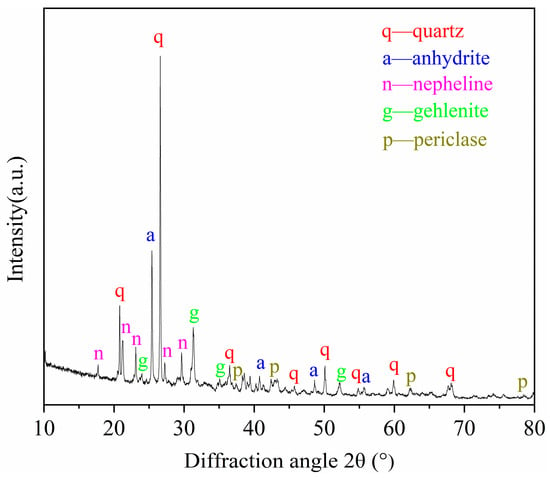
Figure 2.
The XRD pattern of coal ash.

Table 4.
Ash composition of SL lignite.
2.4. Characterization of the Extracts
Elemental analysis (CHNS mode) was conducted using a Vario EL III elemental analyzer. The coal ashes were examined with an SmartLab SE X-ray diffractometer (Rigaku, Tokyo, Japan) with Cu Kα radiation (40 kV, 40 mA). The ash compositions were analyzed using an ZSX Primus IV X-ray fluorescence spectrometer (Rigaku, Tokyo, Japan). FTIR spectra of the HPCD extracts were recorded at ambient temperature using a PE Spectrum One IR spectrometer. For FTIR measurements, each sample was mixed with KBr at a mass ratio of 1:100 and pressed into a pellet. GPC analysis was performed isothermally on a LC-20AT (Shimadzu, Kyoto, Japan) high-performance liquid chromatography system equipped with a Shimpack GPC-8025 column (Shimadzu, Kyoto, Japan) at 25 °C. THF was used as the mobile phase at a flow rate of 1.2 mL/min. SF spectra were recorded using a F-4600 spectrophotometer (Hitachi, Tokyo, Japan), with a 150 W xenon lamp as the excitation source. The difference between excitation and emission wavelengths was set to 14 nm. Spectral measurements were performed at room temperature using a 1 cm quartz cell. The samples were dissolved in THF at a concentration of 5 μg/mL.
3. Results and Discussion
3.1. Extraction Yields of HPCD
Figure 3 shows the yields of HPCD extracts obtained using various solvents. The solvents differ markedly in structure and properties: n-hexane is an alkane, toluene is an aromatic hydrocarbon, and diethyl ether, ethyl acetate, and methanol contain different oxygen-containing functional groups—ether, ester, and hydroxyl, respectively. As shown in Figure 3, the extraction yields YHE, YTE, YDEE, YEAE, and YME are 7.1%, 25.0%, 27.9%, 46.1%, and 60.5%, respectively, and increase with the polarity of the solvent. The higher extraction yields of HPCD in oxygen-containing solvents suggest that HPCD contains a substantial number of polar functional groups, particularly oxygen-containing groups, capable of forming hydrogen bonds. These bonds may be disrupted or released by polar solvents, resulting in increased solubility. The fact that YTE is more than three times YHE further suggests that HPCD contains a considerable proportion of aromatic structures and relatively few aliphatic alkyl structures.
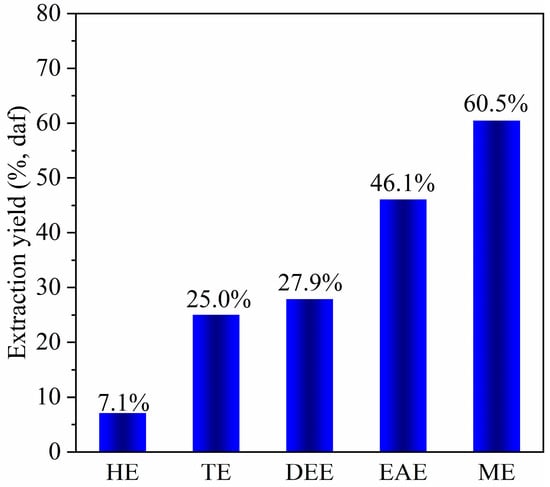
Figure 3.
Extraction yields of HPCD with five solvents.
To further investigate the relation between extraction yield (Y) and solvent polarity, Figure 4 shows the variation in extraction yield with the dipole moment (μ) of each solvent. The extraction yield increases nearly linearly from 7.4% (YHE) to 60.5% (YME) as the μ value increases from 0 (n-hexane) to 2.87 (methanol). This linear trend suggests that the extraction yield of HPCD is primarily governed by solvent polarity.
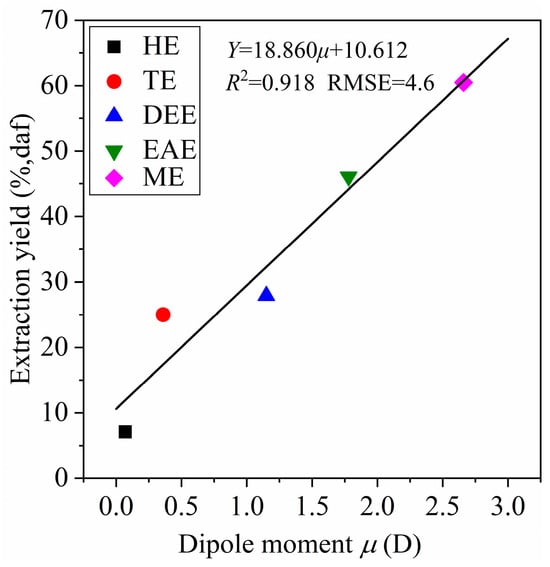
Figure 4.
Variation in extraction yields with solvent dipole moment (μ).
3.2. Elemental Analysis of HPCD Extracts
The elemental compositions of the HPCD extracts are listed in Table 5. The carbon content (C%) decreases from 79.98% in HE to 70.11% in ME as the solvent polarity increases, indicating that the proportion of heteroatoms in the extracts rises while the proportion of the carbon framework decreases. Since the oxygen content (O%) is substantially higher than that of sulfur (S%) and nitrogen (N%) in all extracts, the polar functional groups present are primarily oxygen-containing. Both the O% and the O/C ratio increase from 8.78% and 0.082 (HE) to 21.15% and 0.226 (ME), respectively, further confirming the enrichment of oxygen-containing functional groups in the extracts as solvent polarity increases.

Table 5.
Elemental composition of the extracts of HPCD.
Table 5 also shows that both H% and the H/C ratio of the extracts decrease with increasing solvent polarity. HE exhibits the highest H% and H/C ratio (9.66% and 1.45, respectively), while ME shows the lowest values (6.39% and 1.09, respectively). These trends suggest that the content of aliphatic structures—characterized by higher H/C ratios—decreases, whereas the aromatic structures—characterized by lower H/C ratios—increase with solvent polarity.
Figure 5 presents the variation in H/C and O/C ratios with extraction yield. The O/C ratio increases from 0.082 (HE) to 0.226 (ME) as the extraction yield increases from 7.1% to 60.5%. Notably, the O/C ratios of DEE, EAE, and ME are considerably higher than those of HE and TE, and the corresponding extraction yields (YDEE, YEAE, and YME) are also markedly higher. These results suggest that HPCD contains a considerable number of oxygen-containing functional groups such as ethers, esters, and hydroxyls. According to the “like-dissolves-like” principle, the high extraction yields in polar solvents reflect better solubility of these functional groups. In particular, the highest yield obtained with methanol (YME) may be attributed to its ability to disrupt existing hydrogen bonds in HPCD and form new hydrogen bonds with polar moieties in the extract. In contrast to the O/C ratio, the H/C ratio decreases from 1.45 (HE) to 1.09 (ME) with increasing extraction yield. This inverse relation suggests that molecules with lower H/C ratios (i.e., more aromaticity) also have higher O/C ratios, indicating that these molecules are rich in oxygen-containing functional groups.
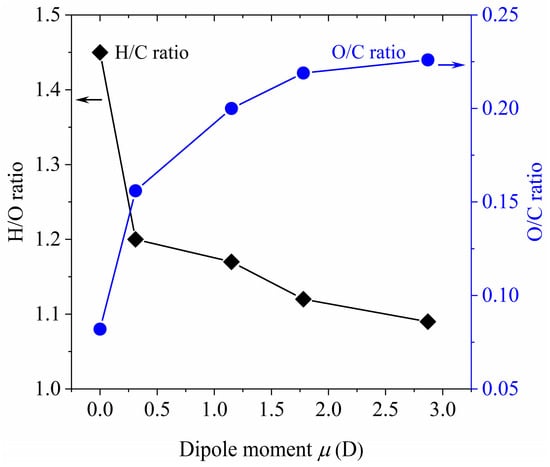
Figure 5.
Changes in H/C and O/C ratios of the extracts with the extraction yield.
3.3. FTIR Spectra of the Extracts
The FTIR spectra of the extracts are shown in Figure 6. All extracts exhibit a broad and intense O–H stretching band in the range of 3700–3100 cm−1, indicative of the presence of hydroxyl groups involved in hydrogen bonding. The peak near 1700 cm−1 in all extracts corresponds to carbonyl (C=O) stretching vibrations. The absorption bands between 1300 and 1000 cm−1 are attributed to C–O stretching in phenols, Car–O–Car linkages, alcohols, and Car–O–Cal structures. These features confirm the presence of phenolic, alcoholic, and ether groups, which align with the high oxygen content observed in elemental analysis. The absorption peaks in the range of 3000–2800 cm−1 correspond to aliphatic C–H stretching vibrations, suggesting the presence of –CH, –CH2, and –CH3 groups. The peaks at 1385 and 1450 cm−1 are assigned to the in-plane bending vibrations of –CH3 and –CH2, respectively. These aliphatic groups likely exist as bridge structures between aromatic nuclei or as substituents on aromatic rings. All extracts display aromatic C=C stretching vibrations at 1610 and 1510 cm−1 as well as aromatic C–H out-of-plane bending vibrations between 900 and 700 cm−1, indicating the presence of aromatic ring structures in all extracts.
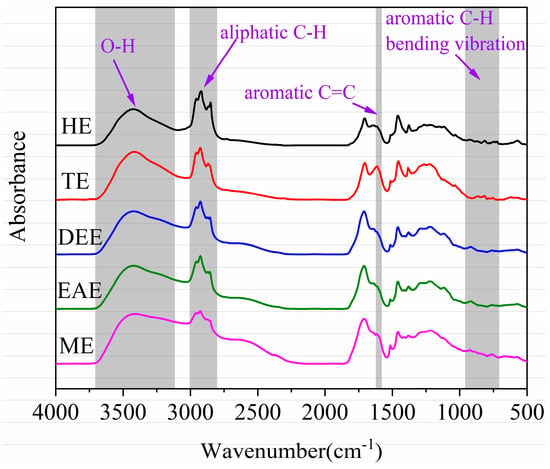
Figure 6.
FTIR spectra of the extracts.
FTIR spectroscopy can be used for the semiquantitative structural evaluation of the HPCD extracts. To gain deeper insights into the structure of these extracts, several relative structural parameters were calculated according to Equations (6)–(9) [23,24,25].
In Equations (6)–(9), Am−n represents the integrated area between m and n cm−1. The region 3000–2800 cm−1 includes the aliphatic C–H stretching vibrations, such as CH2 symmetric stretching (SyCH2), CH3 symmetric stretching (SyCH3), CH asymmetric stretching (AsyCH), CH2 asymmetric stretching (AsyCH2), and CH3 asymmetric stretching (Asy CH3). A2920 and A2950 correspond to the areas under the peaks at 2920 and 2950 cm−1, attributed to the asymmetric stretching of the CH2 and CH3 groups, respectively. These were determined by fitting the FTIR spectra in the 3000–2800 cm−1 range using Gaussian functions. Similarly, A1610, associated with aromatic C=C stretching, was obtained by curve fitting in the 1850–1550 cm−1 region. An example of the fitting process for the DEE extract is shown in Figure 7. The OH/HC ratio reflects the relative abundance of hydroxyl groups compared to hydrocarbon structures. The parameter I indicates the relative abundance of aromatic versus aliphatic functional groups. The degree of condensation (DOC) is used to evaluate the size of the aromatic nuclei—higher DOC values imply smaller aromatic nuclei [26]. The CH2/CH3 intensity ratio provides information about the length and branching degree of aliphatic side chains. Figure 8, Figure 9, Figure 10 and Figure 11 show the variation of OH/HC, I, DOC, and CH2/CH3 as a function of the solvent dipole moment (μ) and extraction yield.
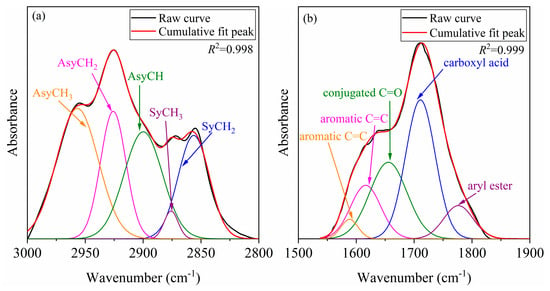
Figure 7.
Curve-fitted FTIR spectra of the DEE extract in the region of (a) 3000–2800 cm−1 and (b) 1850–1550 cm−1.
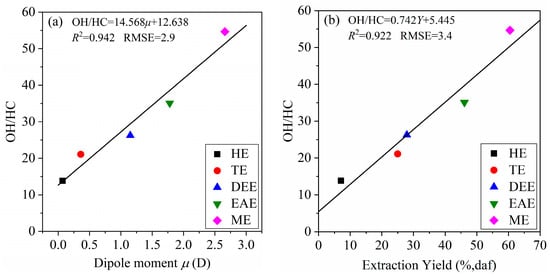
Figure 8.
Changes in OH/HC of the extracts with μ (a) and extraction yield (b).
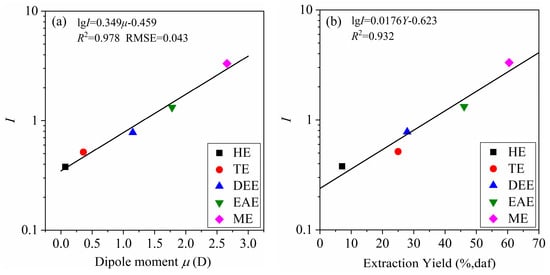
Figure 9.
Changes in I of the extracts with μ (a) and extraction yield (b).
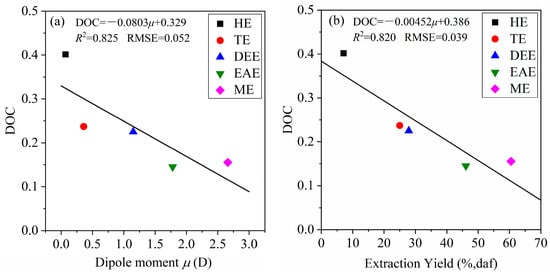
Figure 10.
Changes in DOC of the extracts with μ (a) and extraction yield (b).
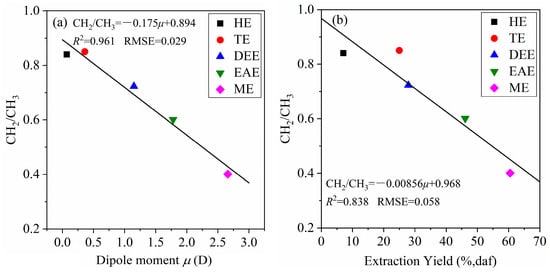
Figure 11.
Changes in CH2/CH3 of the extracts with μ (a) and extraction yield (b).
As shown in Figure 8a, the OH/HC ratio increases linearly with increasing solvent polarity (μ). This trend is consistent with the observations in Figure 6, where the peaks corresponding to O–H, carbonyl, and C–O vibrations become broader and more intense with increasing polarity. This is also in agreement with the O% and O/C ratios presented in Table 5. These findings suggest that higher-polarity solvents extract more oxygen-containing functional groups from HPCD. Figure 8b shows that OH/HC also increases linearly with extraction yield, indicating that HPCD is rich in hydroxyl groups. This result implies that HPCD—particularly the ME and EAE fractions—may serve as promising feedstocks for the production of oxygen-containing compounds.
Figure 9a shows that the I ratio of the extracts increases with increasing solvent polarity (μ), indicating a relative increase in aromatic structures and a decrease in aliphatic structures as solvent polarity increases. This trend is consistent with the H/C ratios presented in Table 5. Similarly, Figure 10a demonstrates that the DOC values of the extracts decrease with increasing μ, suggesting that the size of the aromatic nuclei increases with solvent polarity. Although it is generally understood that aromatic hydrocarbons are more readily soluble in aromatic rather than polar solvents, this apparent contradiction implies that the extracted species with larger aromatic nuclei also contain more hydroxyl groups. This interpretation is supported by the similar trends observed in the OH/HC ratio (Figure 8) and the I ratio (Figure 9). Figure 9b and Figure 10b further support this conclusion, showing that the I ratio increases and the DOC values decrease with increasing extraction yield. These results indicate that HPCD contains a notable proportion of components with large aromatic systems, particularly in the fractions with higher extraction yields.
Figure 11a shows that the CH2/CH3 ratio of the extracts decreases as solvent polarity (μ) increases, indicating a shortening of the alkyl chains in the extracts. Likewise, Figure 11b reveals that the CH2/CH3 ratio decreases with increasing extraction yield, suggesting that HPCD contains a larger proportion of components with shorter alkyl side chains. These observations imply that HPCD is less suited for the production of long-chain hydrocarbons such as fuel oils and is more suitable as a feedstock for manufacturing aromatic hydrocarbon–derived chemicals.
3.4. GPC Molecular Weight of the Extracts
Figure 12 presents the GPC curves of the HPCD extracts, and Table 6 summarizes their number-average molecular weight (Mn), weight-average molecular weight (Mw), and polydispersity (d), calculated from the GPC data. As shown in Table 6, with the exception of HE, the Mn and Mw values of all extracts exceed 500 amu, indicating that the extracts comprise relatively large molecular species. This suggests that the efficient conversion of HPCD into valuable chemicals will require breaking specific covalent bonds within these macromolecular structures. Both Mn and Mw increase with solvent polarity, indicating that polar solvents tend to extract larger molecular species from HPCD. Similarly, the polydispersity index (d) increases with solvent polarity, suggesting that the molecular composition of the extracts becomes increasingly complex as solvent polarity rises. Interestingly, although DEE is more polar than toluene, the Mw of TE (857 amu) is higher than that of DEE (717 amu). This indicates that TE contains a greater proportion of large molecules as these have a disproportionate influence on Mw. Among all of the extracts, TE exhibits the highest polydispersity (1.66) and the broadest GPC distribution. As shown in Figure 12, the lower molecular weight limit of the TE curve is comparable to that of HE, while its upper limit exceeds that of EAE, reflecting a wide range of molecular sizes in TE.
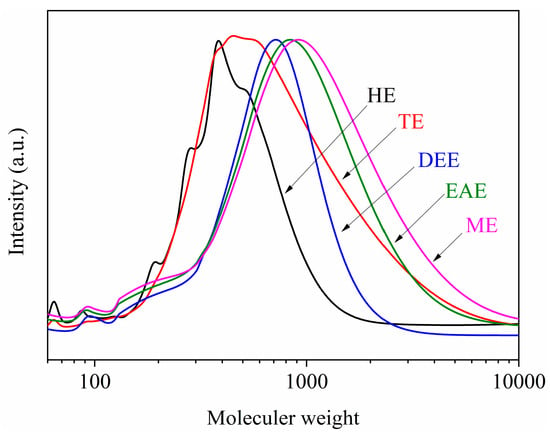
Figure 12.
GPC curves of the extracts.

Table 6.
Mn, Mw, and d of the extracts of HPCD.
Toluene is commonly used to extract asphaltenes from DCL products. Although asphaltenes are not expected to form under the experimental conditions used here, it is speculated that the TE extract contains both weakly polar HPCD components and native asphaltene-like substances present in the coal [27]. This dual contribution may account for the unusually high Mw and the largest d observed for TE.
3.5. SF Spectra of the Extracts
Figure 13 shows the SF spectra of the HPCD extracts. SF spectroscopy is a valuable technique for characterizing the size distribution of fused aromatic nuclei in coal derivatives such as heavy oil, asphaltene, and preasphaltene. It is generally accepted that the fluorescence peaks in the ranges of 270–300, 300–340, 340–400, and 400–425 nm correspond to aromatic systems containing one, two, three, and four fused rings, respectively [22]. As shown in Figure 13, all extracts display considerable spectral overlap, reflecting the complex molecular composition of these mixtures. The fluorescence intensity is primarily concentrated in the 270–340 nm range. Considering the “redshift” effect of substituents such as alkyl and hydroxyl on the SF spectrum [28], the extracts mainly comprise one- to three-ring aromatic structures. This distribution is similar to that found in lignite, suggesting that the aromatic cores of SL lignite are largely preserved during the preparation of HPCD. The molecular weights of typical one- to three-ring aromatics such as benzene (78 amu), naphthalene (128 amu), and anthracene (178 amu) are notably lower than the molecular weights reported in Table 6, implying that the extract molecules are either heavily substituted or comprise multiple aromatic units connected via aliphatic linkages. Therefore, the selective cleavage of these bridge bonds offers a potential pathway for producing valuable aromatic chemicals.
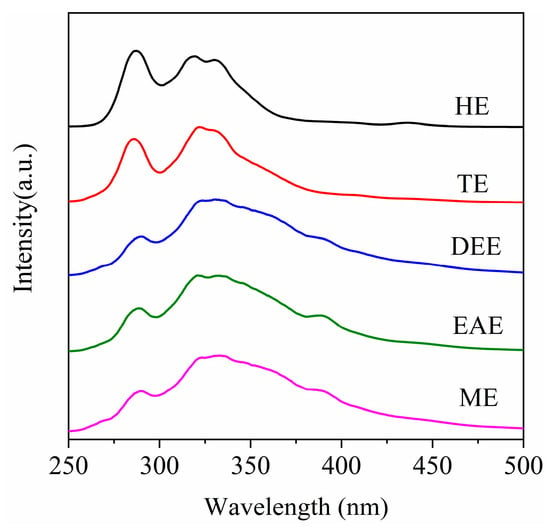
Figure 13.
SF spectra of the extracts.
To study the aromatic structure of the extracts in detail, the SF spectra were fitted by peaks, taking HE as an example, and the results are shown in Figure 14a. The content distribution of the different aromatic nuclei in the extracts is shown in Figure 14b. Figure 14b shows that with increasing solvent polarity, the relative content of monocyclic and bicyclic aromatic nuclei in the extracts decrease, while the content of tricyclic and above aromatic nuclei gradually increase. These variations indicate that more polar solvents tend to extract molecules with larger aromatic systems, which is consistent with the DOC trends observed in Figure 10. In addition, when correlated with the O/C ratios in Table 5 and the OH/HC ratios in Figure 8, it is evident that the extracts containing larger aromatic cores also possess more oxygen-containing functional groups, enhancing their solubility in polar solvents. Based on the structural characteristics of the extracts, the high-polarity extracts are suitable for the preparation of oxygen-containing aromatic hydrocarbon derivatives. For example, ME and EAE may be suitable for the preparation of aromatic carboxylic acids through oxidation.
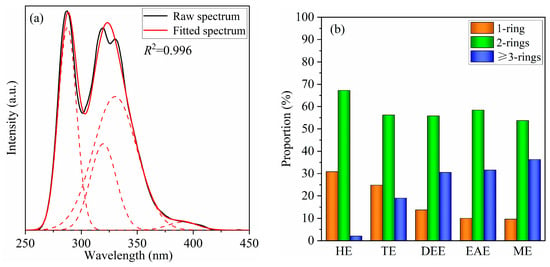
Figure 14.
(a) The fitting curves of the SF spectrum for HS; (b) the content distribution of aromatic nuclei in extracts.
4. Conclusions
The HPCD extract yield is primarily determined by the properties of the extraction solvent and increases with solvent polarity. This trend reflects the presence of abundant polar functional groups—mainly oxygen-containing moieties—in HPCD, which form strong hydrogen bonds that can be disrupted by the polar solvent. The structural characteristics of the HPCD extracts vary systematically with solvent polarity. As the polarity increases, the O/C ratio, molecular size, content of oxygen-containing functional groups, proportion of aromatic structures, and the size of aromatic nuclei in the extracts all increase. In contrast, the H/C ratio and the proportion of aliphatic structures decrease. Consequently, the more polar components in the extracts have larger aromatic fragments, higher molecular weights, and a greater aromaticity than less polar components. The selective cleavage of the bridge bonds linking aromatic nuclei in HPCD holds promise as a strategy for producing aromatic chemicals. The comprehensive characterization of these extracts provides a deeper understanding of their molecular structure, which is essential for advancing staged conversion and utilization strategies for HPCD.
Author Contributions
Conceptualization, M.L. and Z.L.; methodology, Z.L.; software, Y.T.; validation, M.L. and Y.Y.; formal analysis, M.L. and Y.Y.; investigation, M.L., Y.T. and Y.Y.; resources, Z.L.; data curation, Y.T.; writing—original draft preparation, M.L.; writing—review and editing, Z.L.; visualization, Y.Y.; supervision, M.L. and Z.L.; project administration, Z.L.; funding acquisition, M.L. and Z.L. All authors have read and agreed to the published version of the manuscript.
Funding
This research was funded by the National Natural Science Foundation of China (Grant 21978003) and the Cultivation Program for the Outstanding Young Teachers of Anhui Province (Grant YQZD2023082).
Data Availability Statement
The original contributions presented in this study are included in the article. Further inquiries can be directed to the corresponding authors.
Conflicts of Interest
The authors declare no conflicts of interest.
Abbreviations
The following abbreviations are used in this manuscript:
| SL lignite | Shengli lignite |
| FTIR | Fourier-transform infrared spectroscopy |
| GPC | Gel permeation chromatography |
| SF | Synchronous fluorescence spectroscopy |
| HPCD | HyperCoal from the depolymerization of coal |
| THF | Tetrahydrofuran |
| DCL | Direct coal liquefaction |
| HE | n-hexane extract |
| TE | Toluene extract |
| DEE | Diethyl ether extract |
| EAE | Ethyl acetate extract |
| ME | Methanol extract |
| SyCH2 | CH2 symmetric stretching vibration |
| SyCH3 | CH3 symmetric stretching vibration |
| AsyCH | CH asymmetric stretching vibration |
| AsyCH2 | CH2 asymmetric stretching vibration |
| AsyCH3 | CH3 asymmetric stretching vibration |
References
- Miura, K.; Shimada, M.; Mae, K.; Sock, H.Y. Extraction of coal below 350 °C in flowing non-polar solvent. Fuel 2001, 80, 1573–1582. [Google Scholar] [CrossRef]
- Kawashima, H. Changes in sulfur functionality during solvent extraction of coal in HyperCoal production. Fuel Process. Technol. 2019, 188, 105–109. [Google Scholar] [CrossRef]
- Okuyama, N.; Komatsu, N.; Shigehisa, T.; Kaneko, T.; Tsuruya, S. Hyper-coal process to produce the ash-free coal. Fuel Process. Technol. 2004, 85, 947–967. [Google Scholar] [CrossRef]
- Miura, K.; Nakagawa, H.; Ashida, R.; Ihara, T. Production of clean fuels by solvent skimming of coal at around 350 °C. Fuel 2004, 83, 733–738. [Google Scholar] [CrossRef]
- Kashimura, N.; Takanohashi, T.; Saito, I. Effect of noncovalent bonds on the thermal extraction of subbituminous coals. Energy Fuels 2006, 20, 1605–1608. [Google Scholar] [CrossRef]
- Liu, M.; Lei, Z.; Gao, L.; Yan, J.; Shui, H.; Wang, Z.; Xu, Z.; Ren, L. Hydro-liquefaction of the ashless coal from de-polymerization of Shengli lignite. Fuel 2023, 349, 128653. [Google Scholar] [CrossRef]
- Hao, L.; Feng, P.; Song, W.; Lin, W.; Yoon, S.; Mochida, I. Modification performance of Hypercoal as an additive on co-carbonization of coal. J. Fuel Chem. Technol. 2012, 40, 1025–1031. [Google Scholar] [CrossRef]
- Zhao, J.; Zuo, H.; Wang, G.; Wang, J.; Xue, Q. Improving the coke property through adding HPC extracted from the mixture of low-rank coal and biomass. Energy Fuels 2020, 34, 1802–1810. [Google Scholar] [CrossRef]
- Zou, D.; Yang, X.; Shui, H.; Wang, X.; Pan, C.; Wang, Z.; Lei, Z.; Ren, S.; Kang, S.; Li, Z.; et al. Liquefaction of thermal extracts from co-thermal dissolution of a sub-bituminous coal with lignin and reusability of Ni-Mo-S/Al2O3 catalyst. J. Fuel Chem. Technol. 2019, 47, 23–29. [Google Scholar] [CrossRef]
- Wang, J.; Sakanishi, K.; Saito, I. High-yield hydrogen production by steam gasification of HyperCoal (ash-free coal extract) with potassium carbonate: Comparison with raw coal. Energy Fuels 2005, 19, 2114–2120. [Google Scholar] [CrossRef]
- Zhao, X.; Huang, S.; Cao, J.; Xi, S.; Wei, X.; Kamamoto, J.; Takarada, T. KOH activation of a HyperCoal to develop activated carbons for electric double-layer capacitors. J. Anal. Appl. Pyrolysis 2014, 105, 116–121. [Google Scholar] [CrossRef]
- Koyano, K.; Takanohashi, T.; Saito, I. Catalytic Hydrogenation of HyperCoal (Ashless Coal) and Reusability of Catalyst. Energy Fuels 2009, 23, 3652–3657. [Google Scholar] [CrossRef]
- Sakimoto, N.; Koyano, K.; Takanohashi, T. Relationship between extraction yield of coal by polar solvent and oxygen functionalities in coals. Energy Fuels 2013, 27, 6594–6597. [Google Scholar] [CrossRef]
- Takanohashi, T.; Shishido, T.; Kawashima, H.; Saito, I. Characterisation of HyperCoals from coals of various ranks. Fuel 2008, 87, 592–598. [Google Scholar] [CrossRef]
- Bimer, J.; Salbut, P.D.; Berlolecki, S. Effect of chemical pretreatment on coal solubilization by methanol-NaOH. Fuel 1993, 72, 1063–1068. [Google Scholar] [CrossRef]
- Li, S.; Xu, C.; Qin, S.; Guo, X.; Bai, Y.; Guo, F. Molecular characteristics of biochar-derived organic matter sub-fractions extracted by ultrasonication. Sci. Total Environ. 2022, 806, 150190. [Google Scholar] [CrossRef]
- Wang, Z.; Shui, H.; Pan, C.; Li, L.; Ren, S.; Lei, Z.; Kang, S.; Wei, C.; Hu, J. Structural characterization of the thermal extracts of lignite. Fuel Process. Technol. 2014, 120, 8–15. [Google Scholar] [CrossRef]
- Vargas, V.; Castillo, J.; Bouyssiere, B.; Carrier, H.; Radji, S. Study of asphaltenes and sub-fraction nanoaggregates by AFM force spectroscopy. Colloids Surf. A Physicochem. Eng. Asp. 2024, 701, 134638. [Google Scholar] [CrossRef]
- Chen, J.; Bai, Z.; Zheng, H.; Li, W.; Zhang, T.; Jia, Y.; Hou, Y.; Guo, Z.; Kong, L.; Bai, J.; et al. Study on the characteristics and role of the soluble fractions during direct liquefaction for two low rank coals. Part I: Structural comparison between the soluble fractions obtained from soxhlet and thermal extraction. Fuel 2024, 371, 131931. [Google Scholar] [CrossRef]
- Liu, M.; Lei, Z.; Cao, X.; Yan, J.; Shui, H.; Wang, Z.; Hu, J.; Hong, M. Construction of Macromolecules of Depolymerized Lignite. ACS Omega 2023, 8, 22820–22826. [Google Scholar] [CrossRef]
- Jorge, M.; Gomes, J.R.B.; Barrera, M.C. The dipole moment of alcohols in the liquid phase and in solution. J. Mol. Liq. 2022, 356, 119033. [Google Scholar] [CrossRef]
- Meng, X. Dipole moment measure with solution method. Jiangxi Chem. Ind. 2015, 31, 100–103. [Google Scholar]
- Ibarra, J.V.; Munoz, E.; Moliner, R. FTIR study of the evolution of coal structure during the coalification process. Org. Geochem. 1996, 24, 725–735. [Google Scholar] [CrossRef]
- Wang, J.; Tian, L.; Li, G.; Zhao, X.; Liang, Y.; Yu, J. Construction of vitrinite molecular structures based on 13C NMR and FT-IR analysis: Fundamental insight into coal thermoplastic properties. Fuel 2021, 300, 120981. [Google Scholar] [CrossRef]
- Zhu, Y.; Tian, F.; Liu, Y.; Cui, L.; Dan, Y.; Du, C.; Li, D. Comparison of the composition and structure for coal-derived and petroleum heavy subfraction by an improved separation method. Fuel 2021, 292, 120362. [Google Scholar] [CrossRef]
- Ren, H.; Pang, L.; Bai, Z.; Dai, X.; Li, D.; Zhao, M.; Hou, Y.; Chen, J.; Guo, Z.; Kong, L.; et al. Evolution of the plastic phase structure in metallurgical coals with different metamorphic degrees and its relationship with coke thermal strength. J. Fuel Chem. Technol. 2025, 53, 1–15. [Google Scholar] [CrossRef]
- Chen, C.; Gao, J.; Yan, Y. Original preasphaltenes and asphaltenes in coals. Fuel Process. Technol. 1998, 55, 143–151. [Google Scholar] [CrossRef]
- Bayrakceken, S.; Gaines, A.F.; Keating, P.; Snape, C.E. The fluorescence of suspensions of powdered coals. Fuel 2005, 84, 1749–1759. [Google Scholar] [CrossRef]
Disclaimer/Publisher’s Note: The statements, opinions and data contained in all publications are solely those of the individual author(s) and contributor(s) and not of MDPI and/or the editor(s). MDPI and/or the editor(s) disclaim responsibility for any injury to people or property resulting from any ideas, methods, instructions or products referred to in the content. |
© 2025 by the authors. Licensee MDPI, Basel, Switzerland. This article is an open access article distributed under the terms and conditions of the Creative Commons Attribution (CC BY) license (https://creativecommons.org/licenses/by/4.0/).